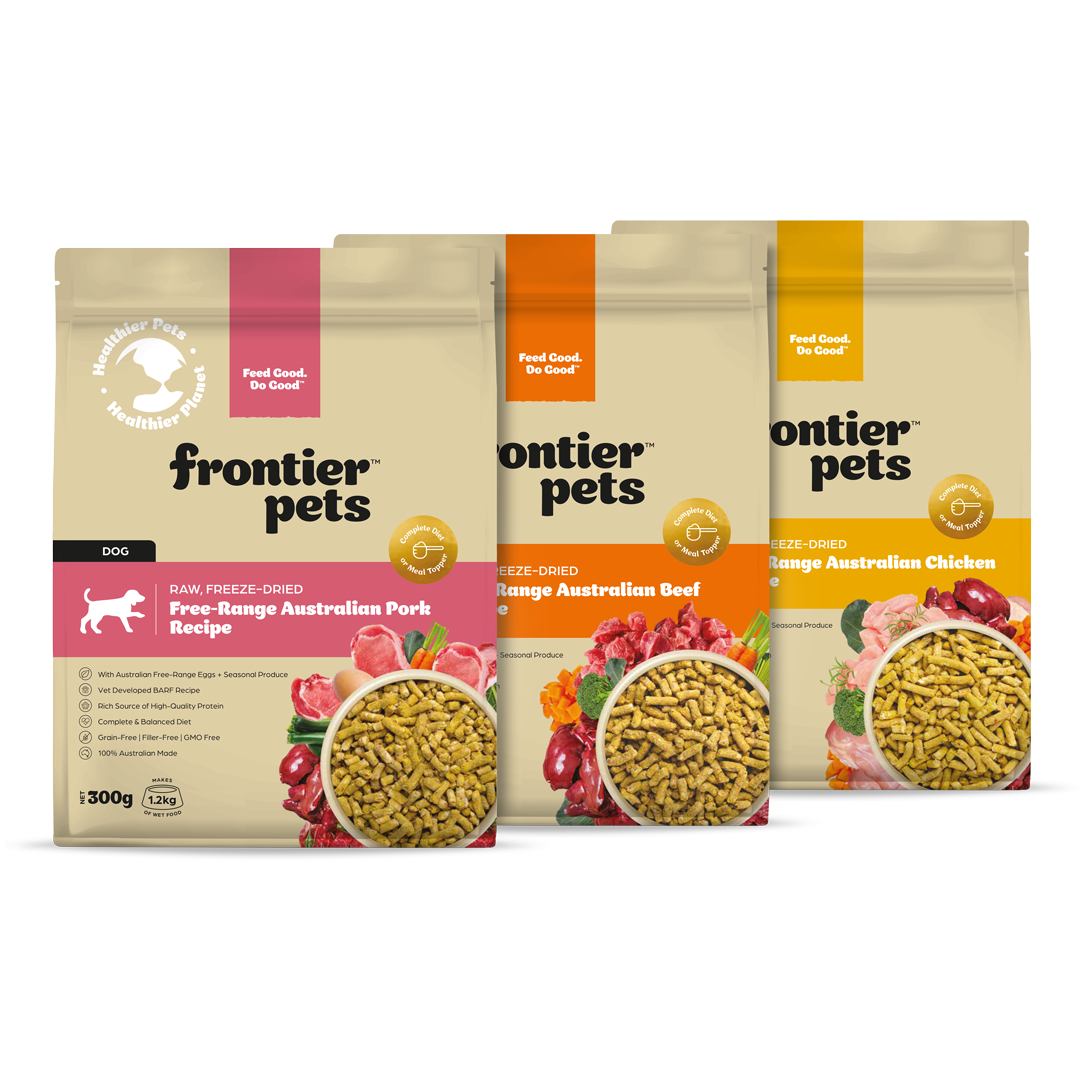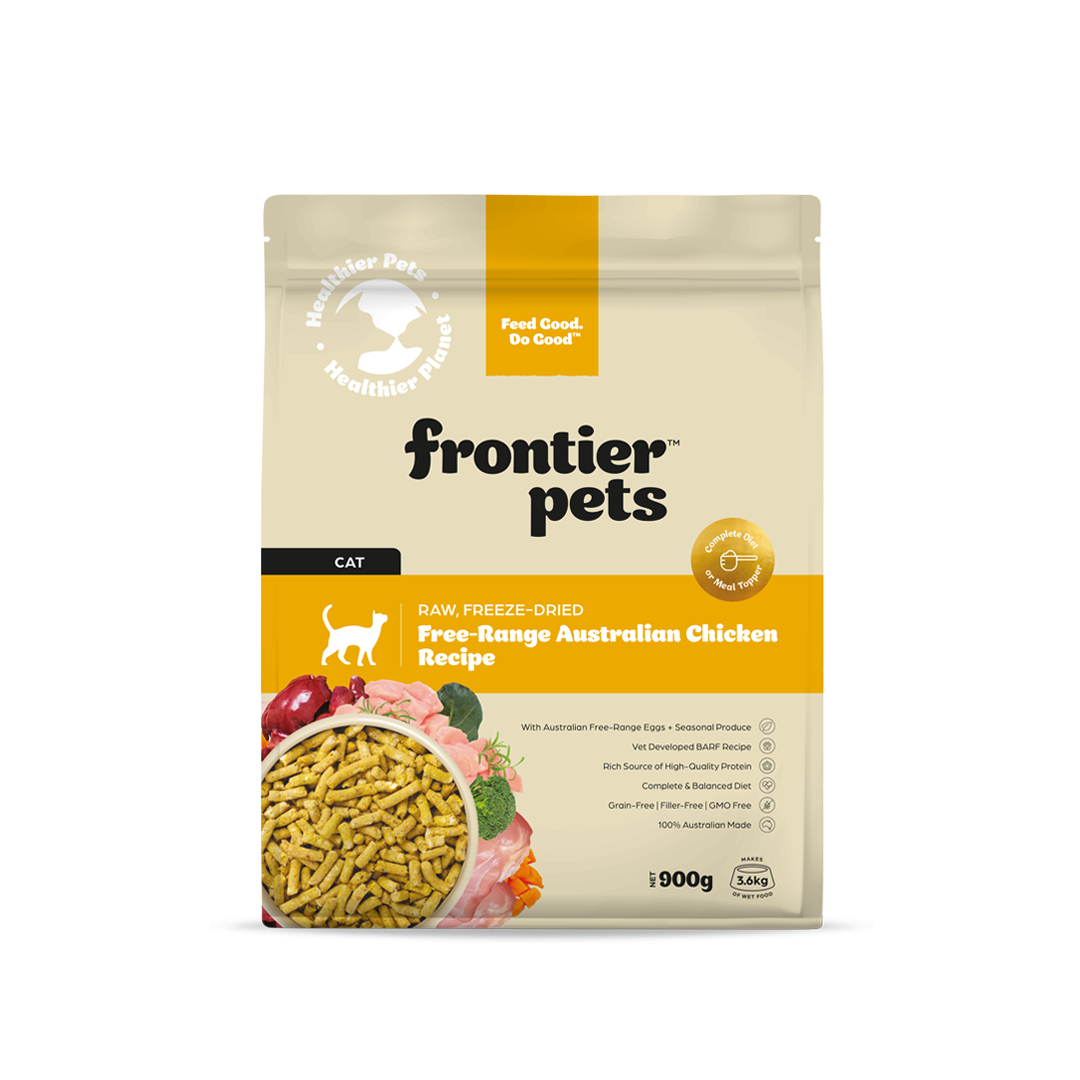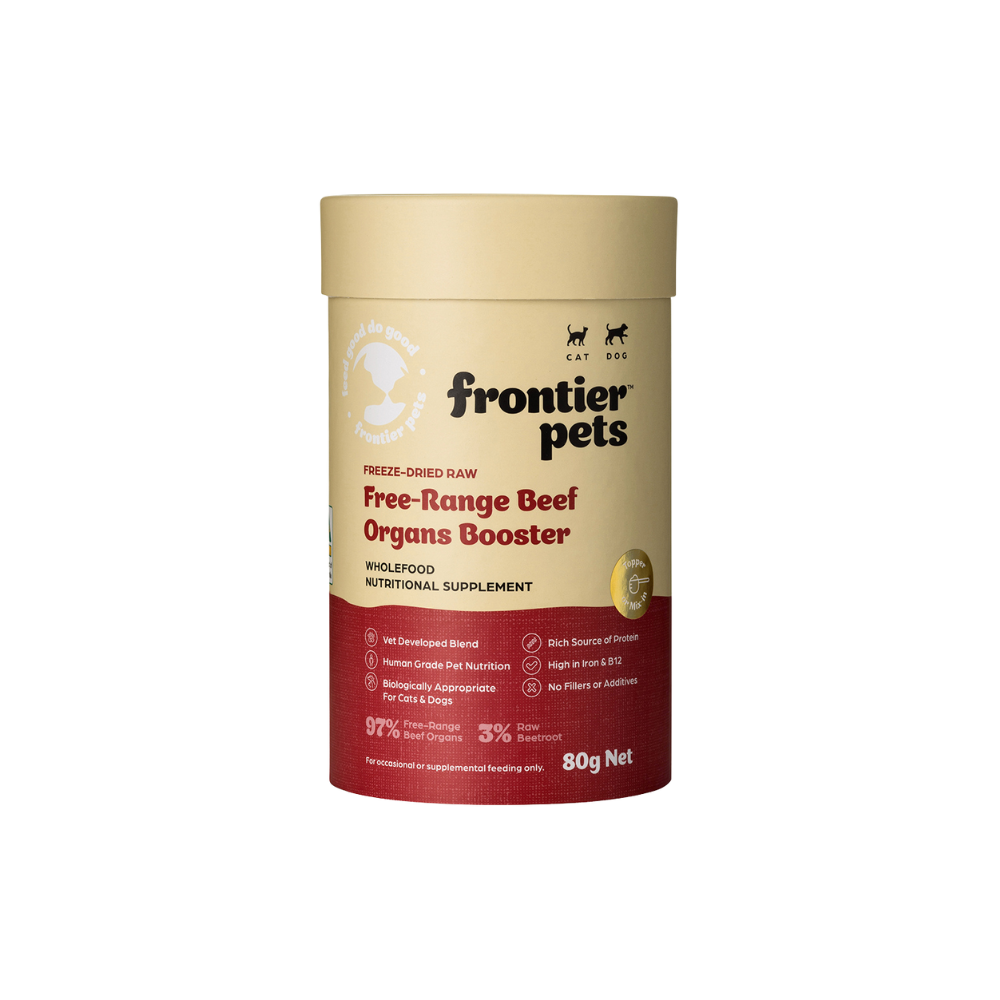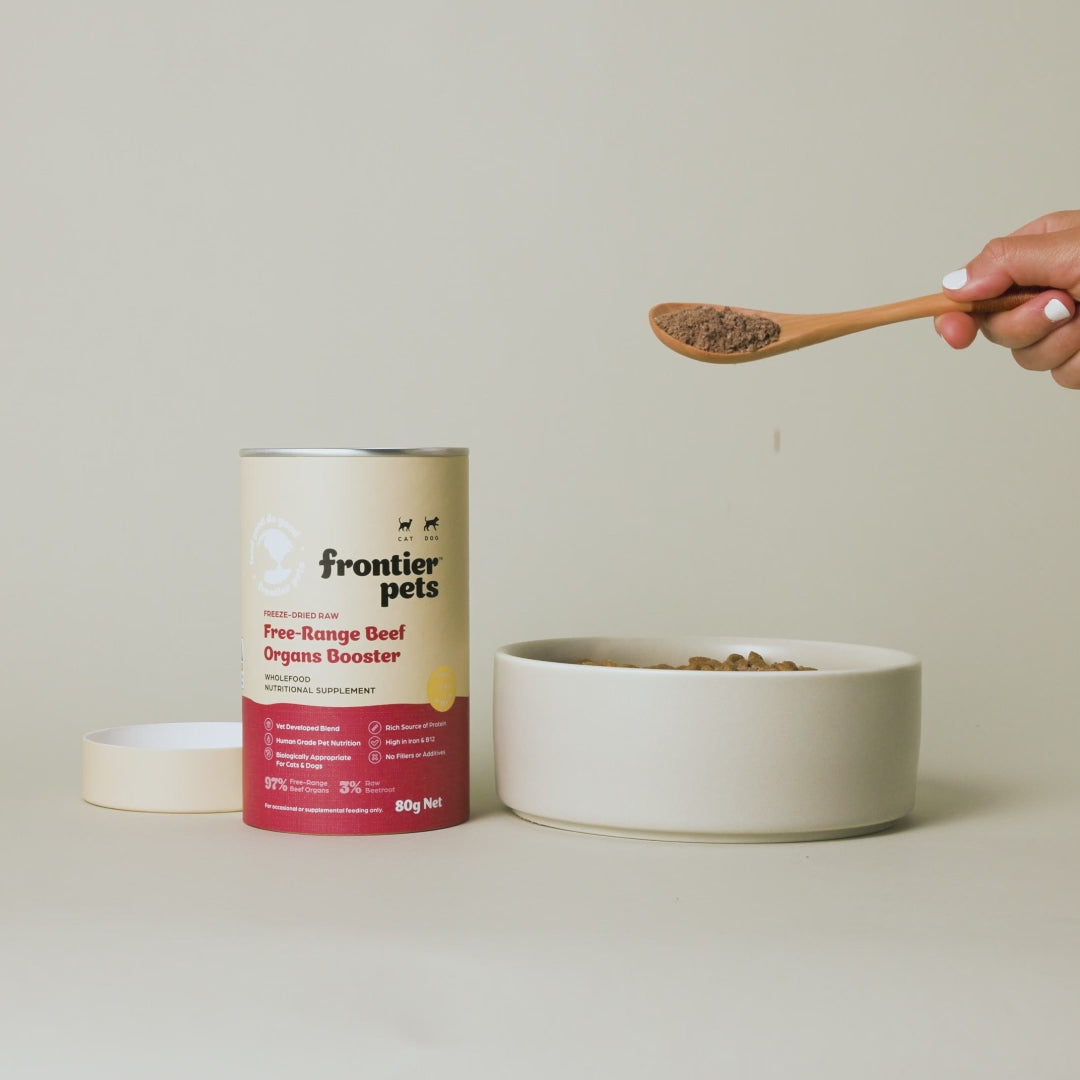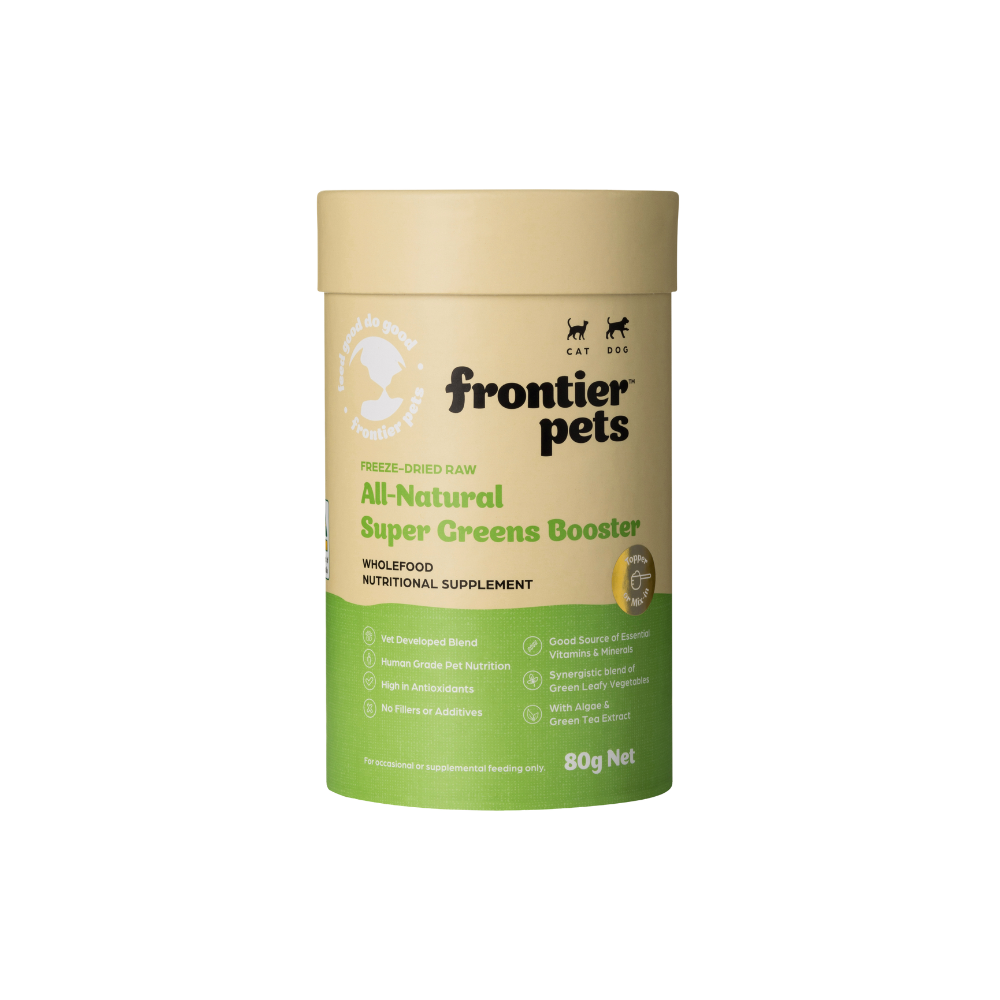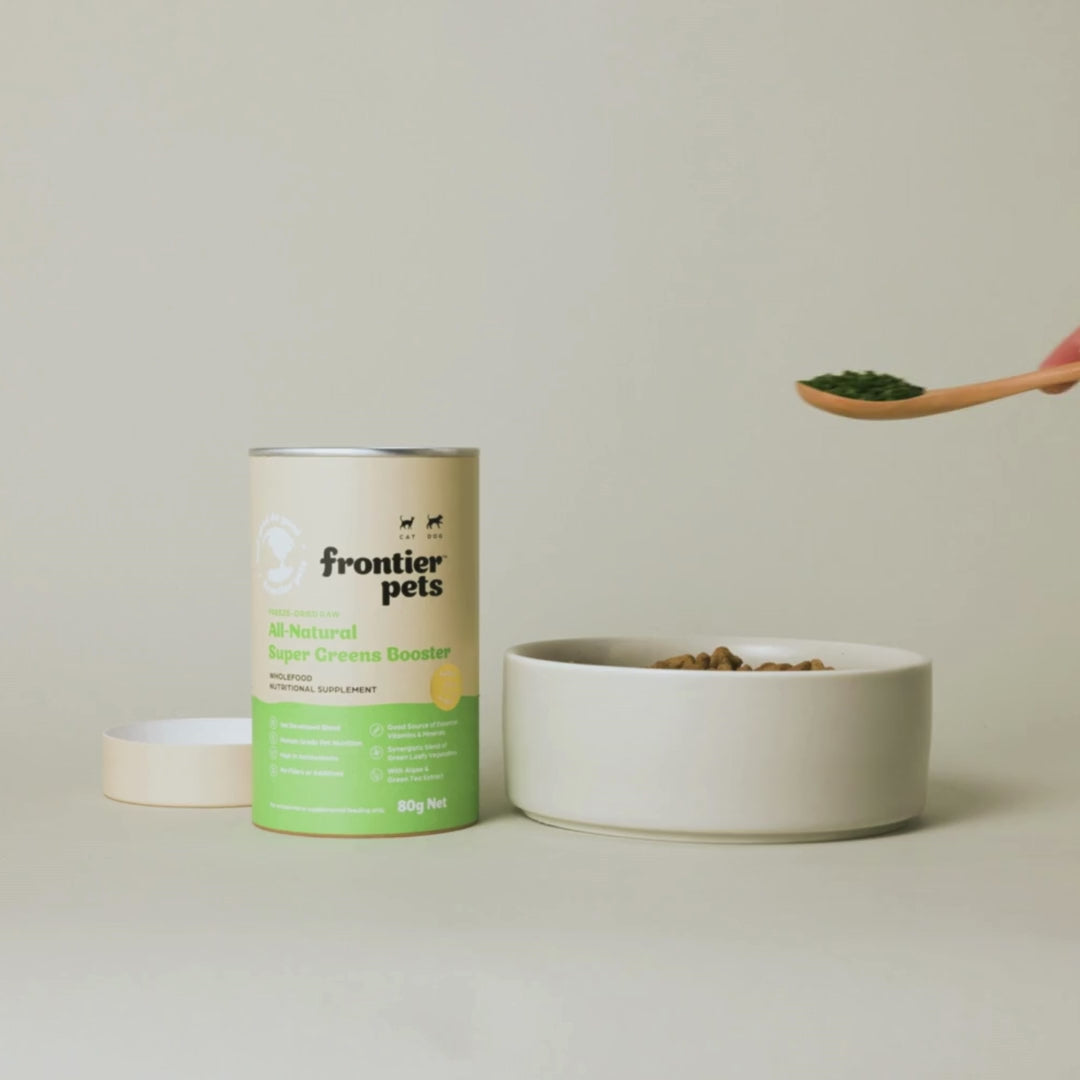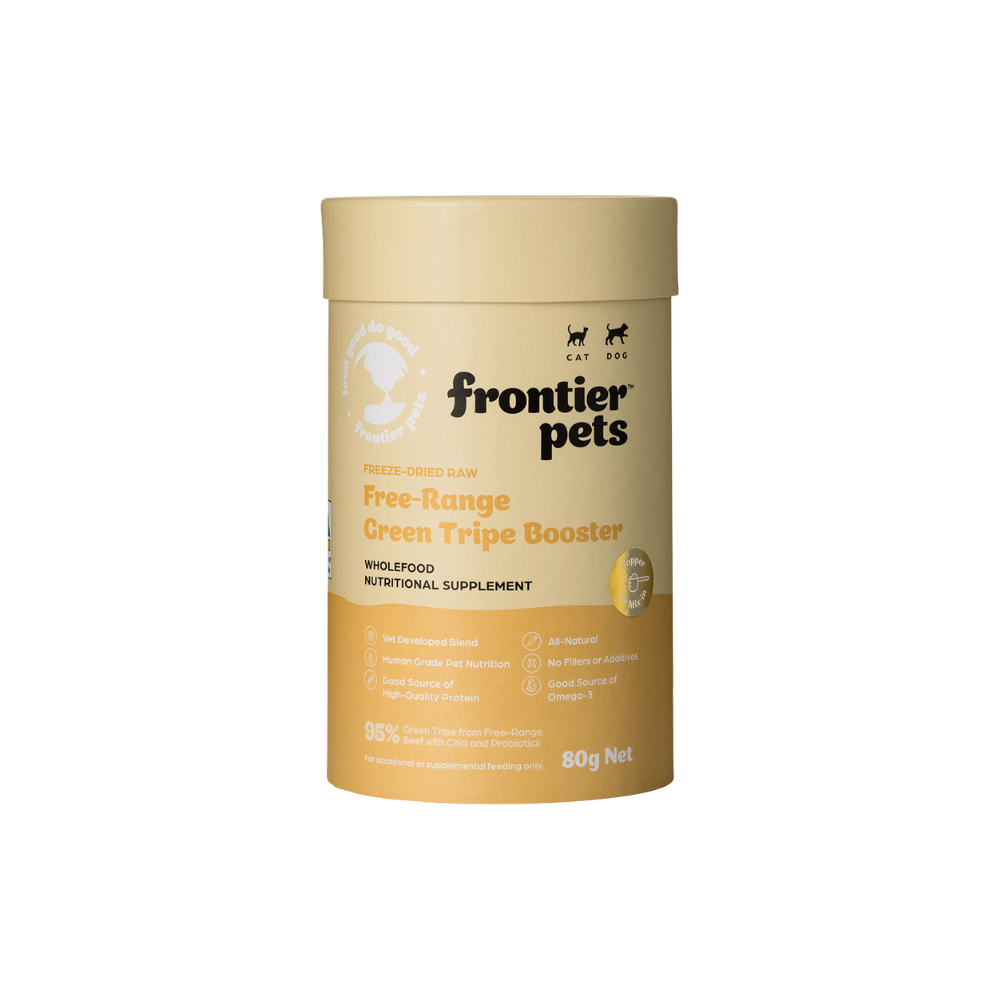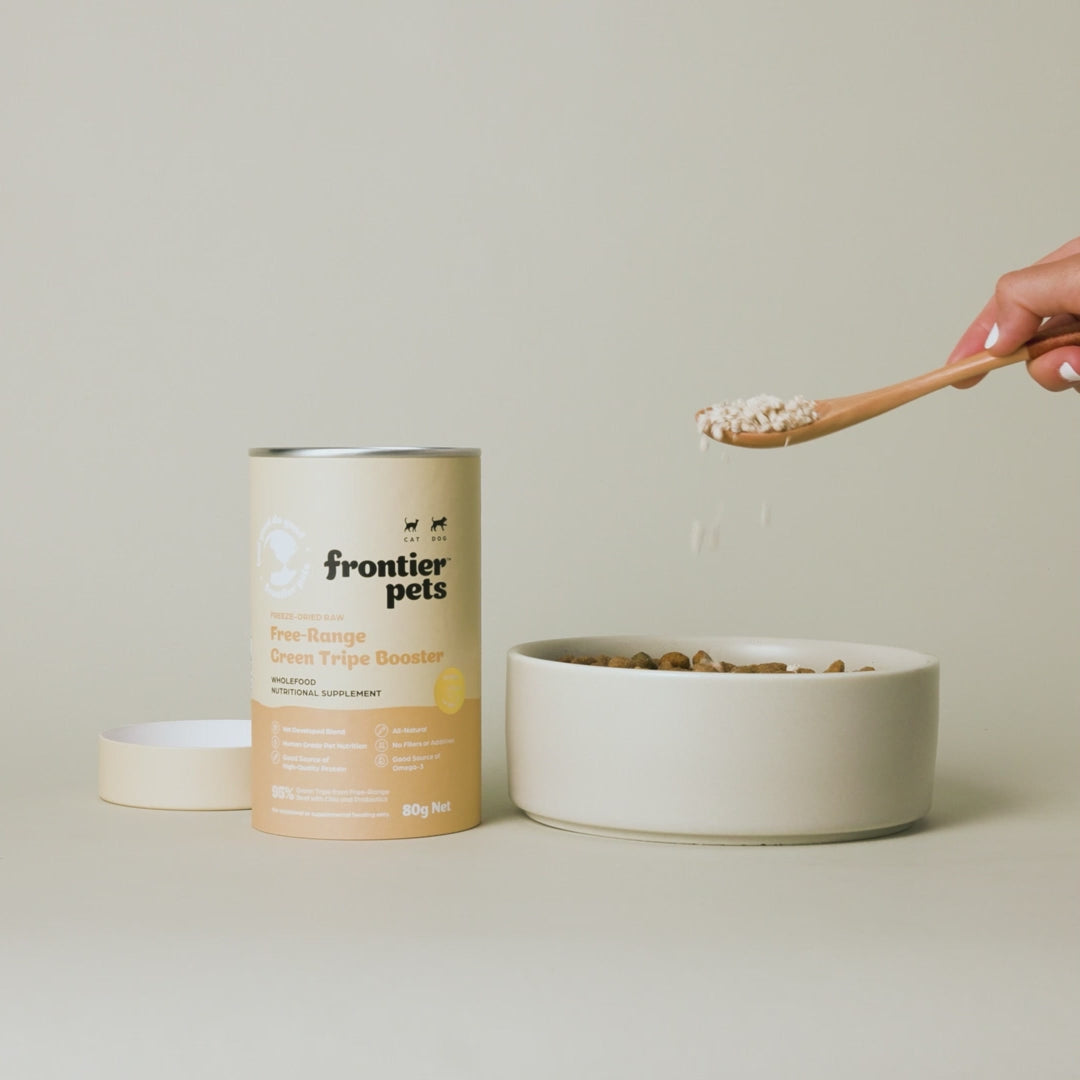Raw Meat Cat Food: The Ultimate Guide to a Raw Meat-Based Diet for Cats

Summary
Thinking about switching your cat to a raw food diet but not sure where to start? A raw meat diet closely mimics what cats would eat in the wild, offering improved digestion, better weight management, and a shinier coat. However, feeding raw isn’t as simple as just giving your cat raw meat—it needs to be balanced with bones, organ meats, and essential nutrients to support their health.
In this guide, we’ll cover everything you need to know about feeding your cat a raw diet, including the best meats to choose, how to transition safely, and whether supplements are necessary. Plus, if meal prep feels overwhelming, we’ll introduce a convenient, vet-formulated alternative—Frontier Pets’ freeze-dried raw food.
Let’s dive in! 🚀
Key Takeaways
✅ Healthier Digestion & Weight Management – A raw diet can support gut health, reduce smelly stools, and help cats maintain an ideal weight.
✅ More Than Just Meat – A balanced raw diet includes bones, organs, and essential nutrients for optimal feline health.
✅ Gradual Transition – Cats don't like change! Introduce raw food slowly to avoid digestive upset.
Why Feed Cats a Raw Meat Diet?
Feeding your cat a raw food diet has been gaining popularity among pet owners who seek a more natural and nutritious option for their feline friends. This guide covers everything you need to know about whole food, meat-based, raw cat diet, from the benefits and best types of ingredients to commercial options and how to transition your cats to raw food tips.
What Are the Benefits of Feeding Raw Meat to Cats?
Feeding cats raw food comes with several notable benefits:
- Improved Digestion: Many cat owners report that a raw diet can help with digestive issues such as constipation and diarrhoea.
- Better Stool: Smaller and less stinky poos. Because a raw, meat-based diet is very digestible, poos will likely be smaller and less stinky.
- Weight Management: A raw diet may benefit cats with weight problems, helping them maintain a healthy weight. Its high water content aids the feeling of fullness, and its high protein content sustains energy for longer than carbohydrate-based diets.
- Allergy Relief: Appropriate whole-food diets are anti-inflammatory by nature. A whole-food, raw diet may help reduce and relieve symptoms for cats with allergies.
- Healthier Coat and Skin: An appropriate raw food diet can provide high-quality protein and unaltered fats, resulting in clearer cat eyes, shinier coat, and healthier skin.
Is Feeding Raw Meat a Complete and Balanced Diet?
No. Cats need more than just meat in a balanced diet. Using natural nutrition principles, the most appropriate food for a cat is a whole mouse, all of it:
✅ Muscle meat (for protein)
✅ Raw bones or a calcium source (for strong bones & teeth)
✅ Organ meats (for essential vitamins & minerals)
✅ Healthy fats (e.g. fish, eggs, or animal fat for brain function)
✅ Prebiotic fibre (for gut health)
To make a balanced raw food diet, it is important to choose a range of ingredients to supply all the nutrition that the whole mouse provides. Getting the diet balanced over time is very important. Seeking professional assistance or consulting a holistic vet is a good resource. There are also excellent books available, such as "Real Cat Food" by Dr. Clare Middle.
What ingredients need to be included in a raw food diet to make it balanced?
Meats of various types make up the bulk of the diet, as cats are an obligate carnivore. That is, they need meat to survive and have a very high protein requirement.
Here’s a quick reference to the best options:
🥩 Beef – Rich in iron and protein. Choose tougher cuts for joint health & natural collagen.
🍗 Chicken (Thighs > Breast) – Thighs are chewier and more nutritious.
🐟 Small Whole Fish (Sardines, Mackerel) – Full of omega-3 fatty acids for skin, coat, and brain health.
🐄 Kangaroo – A lean protein that’s low in fat and high in iron.
🐰 Rabbit & Whole Small Birds (Quail, Pigeon) – A great natural source of bones for calcium.
💡 Pro Tip: Rotate proteins regularly to keep your cat interested and ensure a variety of nutrients.
What general principles do I need to be aware of when feeding raw?
Choosing high-quality ingredients. It is essential when considering a raw food diet for cats. Regarding protein sources, choose cuts with a standard fat content—not overly lean or overly fatty options. Remember, cats need healthy fats and abundant protein in their diet.
Free-range sources of meats are best, and organic ingredients are ideal if your budget allows. It is important to provide a variety of protein choices over time to ensure your cat gets a full range of nutrients. Cats can be picky eaters and may become attached to and prefer one type of food over another. However, it is recommended that cat owners rotate their food and provide variety over time. This also mimics wild cat’s natural feeding patterns.
Here are important things to remember when feeding your cat raw food:
- Avoid feeding fish more than 3-4 times a week to prevent excessive iodine intake, which may lead to thyroid issues later in life.
- Always serve the food at room temperature. Cats are natural hunters and prefer their food to be close to body temperature. Be sure to take the chill off the raw food before feeding it.
- Feeding the food in larger chunks or pieces, not minced, is crucial, as this promotes better dental health and can enhance mental stimulation.
What Kind of Raw Meats Are Best for Cats?
Any meat is appropriate for cats, following the general principles above. Some excellent, readily available choices for cats include:
- Chicken: Choose thigh meat over breast meat for a chewier texture.
- Small Whole Fish: Sardines, mackerel, and pilchards are excellent sources of essential fatty acids, as well as vitamins and minerals.
- Fillets: Fillets are slices of meat or fish boned and skinned. They are an excellent option for your cat’s diet as they provide a clean and straightforward source of protein without any bones, such as cod and flake.
- Beef: Beef is rich in iron and essential nutrients that support overall health and vitality in cats. When selecting beef for your cat, opt for tougher cuts meant for stewing rather than those meant for mincing. Tougher cuts tend to have more connective tissue, which can be beneficial for your cat’s joint health and provide a good source of collagen. These cuts also often come with a richer flavour, making them more appealing to your cat.
- Kangaroo: Kangaroo meat is an excellent source of iron and offers a unique taste that many cats enjoy. It is typically lean, meaning it has less fat compared to other meats, which is beneficial for maintaining a healthy weight. This makes kangaroo a natural and nutritious option for your feline friend.
Other more exotic choices can help with the bone content, including whole small birds, like pigeons or quail, if they are available. It is an excellent source of bones for chewing and nutrition. Rabbit is another option to feed whole or in pieces. Great for providing bone and variety.
Cats need bones: what sort of bones can I feed them?
It's important that bones are fed raw and that you supervise your cat. Start them young as kittens to gain their natural proficiency at chewing bones. A piece of chicken neck or a chicken wing is a great choice. Small whole fish, small whole birds, or dried ground eggshells are other options.
What kind of organ meats can I include?
Feed a small amount of organ meat every day to ensure your cat is getting essential nutrients. To provide that nutritional variety, vary the species of animal from which you get the organ meat. Below, find some great choices.
- Liver: Lamb, beef, or chicken livers are readily available in most supermarkets. However, be cautious not to give too much liver to cats as they can get addicted and may experience health issues due to an excess of Vitamin A. Dried liver treats are also suitable for pets.
- Heart: Both lamb, beef hearts, and chicken hearts whether fresh or dried, are suitable for pets.
- Kidneys: Both lamb and beef kidneys are suitable for pets.
- Green tripe: Both lamb and beef green tripe, whether fresh or dried, are suitable for pets.
🛑 Never feed cooked bones—they splinter and can cause serious harm.
Are There Commercially Available Raw Meat Cat Food Options?
Yes, several commercially available pet food brands make feeding your cat raw meat easier and more convenient. These pet food brands often offer various raw meat diets and options, including frozen and freeze-dried formats, which can be more convenient to store and serve. Frontier Pets is one such brand. Our recipes are holistic, vet-formulated, complete, and balanced. They are easy to feed, delicious, and convenient and take all the stress out of balancing and preparing. We've done it for you.

How Do I Transition My Cat to a Raw Food Diet?
Transitioning your cat to a raw meat diet should be done gradually to avoid digestive upset. Here’s a simple guide:
- Start Slowly: Begin by mixing a small amount of raw food with each of your cat's current meals.
- Increase Gradually: Gradually increase the proportion of raw food every few days while decreasing the amount of the old food over 3-4 weeks.
- Monitor Your Cat: Watch for any signs of digestive issues and adjust as needed. Food refusal is likely. Cats don't like change. If they won't have it, take a step back for a few days, i.e., reduce the amount, and then try again.
- Feed warm: Warm the food to increase acceptance. If they don't eat it, don't give up: Offer it again the next meal or week.
- Consistency is Key: To help your cat adjust, maintain a consistent feeding schedule. Leave food down only some of the time. Offer five minutes to eat it and then take it up.
- Hygiene: Good food hygiene is essential when feeding raw food diets. Do not leave food down as it will spoil.
- Consult with your vet: See your vet if you have any concerns.
🔎 Need more tips? Check out Frontier Pets transition guide for more details on transitioning your cat to our food.
What Supplements Do I Need to Add to Raw Meat Cat Food?
A balanced diet is what a cat needs. We do not recommend feeding raw meat alone, as this will not provide all the necessary nutrients your cat needs. Necessary supplements may include
🟢 Taurine – Essential for heart & eye health (naturally found in organ meats).
🟢 Calcium – Vital for bones & teeth (from bones or eggshell powder).
🟢 Omega-3 Fatty Acids – Supports skin, coat, & joint health (from fish or fish oil).
🟢 Vitamin E – An antioxidant boosting immune health (found in liver).
💡 Did you know? Frontier Pets' freeze-dried raw food is already formulated to meet AAFCO and NRC standards for complete nutrition.
Raw Meat Cat Food Cost & Storage Tips
The cost of raw ingredients can vary, possibly higher than traditional kibble, depending on where you source your meat and how you feed your pet. If you are time-poor, here are some tips.
- Buy what is on special and freeze it in small portions in bags, ice cube trays or small containers.
- Buy in bulk and store in small portions.
- Preparing a raw diet can take time, so a raw cat food delivery service can be an option if you are short on time.
Storage Tips:
- Freeze: Store raw meat in the freezer and thaw only what you need for a few days.
- Safe Handling: To avoid contamination, always handle raw meat carefully, as you would for your meals.
- Proper Containers: Use airtight containers to keep raw meat fresh and prevent odours.
Frontier Pets: An Easy and Balanced Raw Food Option
If preparing a raw food diet for your cat seems daunting, you might consider a ready-made option like Frontier Pets Raw Freeze-Dried Food. Frontier Pets offers a complete and balanced raw diet that requires no preparation. Simply add warm water to rehydrate the freeze-dried food, and it's ready to serve. This makes it an excellent choice for those who want to provide their cats with the benefits of a raw diet without the hassle of preparation. Frontier Pets food can also be fed as dry food, which some cats might love.
Frontier Pets food is formulated to meet or exceed the nutritional levels established by the Association of American Feed Control Officials (AAFCO) and the National Research Council (NRC) UK to be a complete diet and balanced food for adult cats.
Conclusion
A raw food diet for cats may provide health benefits, from improved digestion to better weight management. Always transition your cat carefully, and by including the necessary supplements, you can ensure your cat thrives on a raw food diet. With options like raw cat food delivery and reputable raw cat food brands, feeding a whole food raw diet has always been challenging. For those who prefer a hassle-free solution, Frontier Pets Raw Freeze-Dried Food offers a complete and balanced diet that's convenient and nutritious. Remember to follow our daily feeding guide as a quick reference when feeding your cat's raw, freeze-dried cat food.
This general health advice comes from our holistic veterinarian, Dr. Kathy Cornack. For any specific health concerns about your animal and if a raw diet is right for them, please consult your veterinarian or pet nutritionist. Individual animal needs may vary. This is general advice only.
Frequently Asked Questions (FAQs)
More Blog posts

Best Low Maintenance Dog Breeds in Australia
Choosing your new fluffy companion is never easy. There is a wide range of considerations that go into finding the perfect pup for you! From your lifestyle to your living arrangements, it’s importa...
Read more
Steps With Pets Charity Challenge, August-September 2025
Steps with Pets – Tottenham Hotspur’s global charity dog-walking challenge, supported by Frontier Pets Calling all dog-loving Spurs fans around the world! This is your chance to combine your pass...
Read more
